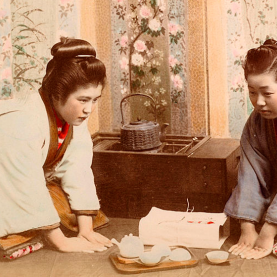The chef’s hat through the ages
At first floppy, then tall and straight, the chef’s hat, or toque, became popular in the 19th century and continues to appeal to chefs as far afield as Japan.
A chef at the entrance to his restaurant, Barga, Tuscany, Italy, 2015. ©iStock/JannHuizenga
Even though numerous legends date the toque back to ancient times, this favourite accessory of top chefs across the globe was not always the norm. The oldest of these legends originates in the 7th century BCE. The Assyrian King Ashurbanipal feared he might be poisoned, so he requested his chefs wear a hat similar to that of the royal family, to be more easily recognised in the palace and show their allegiance to the sovereign.
Another myth regarding the origin of the chef’s hat claims that, to mark the beginning of festivities during Greek and Roman Antiquity, the organisers of feasts equipped their chefs with hats adorned with laurel leaves. According to a third legend, the toque is a copy of the hat worn by Greek Orthodox priests. In the Byzantine Empire, during a period of political unrest in the 6th century, many chefs were said to have sought refuge in monasteries and adopted the monks’ clothing, including their typical cylindrical black hats (‘kamilavkion’)1.
In his book The Curious Cook, the American author Harold McGee explains that, “The origin of the chef’s hat is quite obscure. Other research on the subject has clearly shown that – regardless of what happened in the monasteries in Greece –, the contemporary chef’s hat was really only adopted around 1900.”
A hat for sweltering kitchens
In their Dictionnaire du gastronome, Jean Vitaux and Benoît France describe the use of a rimless and cylindrical Spanish toca in the 15th century. The two French gastronomy enthusiasts then note that, at the end of the Renaissance, European chefs, caterers and roast cooks wore hats similar to nightcaps2.
Jérémie Brucker, a lecturer in contemporary history at the University of Angers in France, and author of a thesis on the history of professional clothing, including chefs’ garments, explains that a chef’s hat was chiefly functional and worn for hygienic purposes. “A chef’s hat was often made of black cotton, and intended to soak up sweat on the brows of those working in sweltering conditions, blackened by the embers of the fireplaces. This headgear also served to prevent hair from falling into food and to protect the wearer from splatters.”
Invented in Vienna
We owe the invention of the contemporary white toque to the French ‘king of chefs and chef of kings’, Marie-Antoine Carême (1784-1833). This master chef, who officiated for Talleyrand, as well as for Tsar Alexander I, first wore it in 18213. At that time, he was working for Lord Steward, the British ambassador to Vienna. As Jérémie Brucker explains, “Impressed by the military uniforms on show at the 1814 Congress of Vienna4, he invented this immaculately white, flat-topped hat, to reflect the purity and rigour to be found both on the plate and in the chef’s appearance.”
Marie-Antoine Carême gave the hat an aesthetic element, to symbolise the prestige of the high-quality cuisine served in Europe’s finest houses. “In the 19th century, it was firmly believed that food should further diplomatic relations,” confirms Jérémie Brucker. Both as a chef and through his books5, Marie-Antoine Carême contributed more widely to the invention of gastronomy and presentation as an art form that spread across the whole of Europe.
Firmly established during the 20th century
However, it was not until the early 20th century that the toque became more widespread, in the version we still know today: straight and with folds This evolution is credited to Auguste Escoffier, another renowned figure of French cuisine and also very active abroad. As Jérémie Brucker explains, “From 1890, the restaurateur at the Savoy Hotel in London invented the concept of kitchen brigades to modernise and codify the profession.”
Auguste Escoffier (1846-1935) streamlined the allocation of tasks and promoted the image of an impeccably dressed team with exemplary behaviour. The toque then became upright and provided the finishing touch to the chef’s uniform of a white double-breasted jacket, a scarf, a neckerchief, an apron and striped trousers. “The spotless white straight toque and uniform are synonymous with cleanliness and moral rectitude and aim to inspire confidence among restaurant clients.”6
International popularity
As the cuisine of the rich and powerful, from diplomatic circles to palaces, developed during the 19th and 20th centuries, so the uniform of the top chefs spread across Europe, then to North America and even Asia. Joji Nozawa, a Japanese historian and author of a thesis on European wines conquering Asia explains that, “When Japan opened up during the Meiji era (1868-1912), the white uniform quickly spread, firstly in restaurants serving western-style food, then in most types of restaurant. During the American occupation, after the Second World War, the wearing of a white outfit was even made a legal obligation for hygiene purposes.”
Today, some Japanese cookery schools encourage their students to wear the European-style toque. However, many chefs prefer an outfit which is completely different from the western uniform. Sushi masters, who study for years under a senior chef to earn the much-coveted title of ‘itamae’7, still often favour a traditional Japanese uniform. They wear a kimono jacket and a bandana called the ‘hachimaki’, made from a strip of absorbent cotton (‘tenugui’), adorned with their surname or a slogan or printed with various designs. Joji Nozawa points out that, “These two garments are found in restaurants specialised in Japanese cuisine, in both luxury and popular establishments.” For the Japanese, the ‘hachimaki’ bandana symbolises not only hard toil, which makes you sweat, but also determination and courage.
Bareheaded, wearing a bandana or a baseball cap, several of today’s trendy chefs have chosen to abandon the toque in order to assert their individuality. This is the case, for example, of Britain’s Jamie Oliver or the German chef Thomas Bühner who, despite his three Michelin stars, is rarely seen in traditional chef’s whites. “In Japan, there are now many restaurants of various styles where chefs dress as they please,” says Joji Nozawa.
According to the Dictionnaire du gastronome, chefs and pastry chefs still wear a toque today, but mainly when they are in front of the public. Almost 200 years after Marie-Antoine Carême invented this particular hat, to the outside world it still embodies the importance many chefs attach to high-quality gastronomy.





















